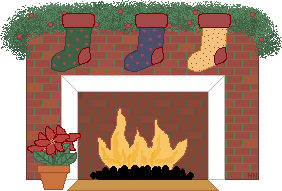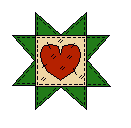Here is what you
will learn about on this winter page:
Gloves & Mittens
Fireplaces
What is the temperature outside? Learn about Fahrenheit
& Celius
Birds and Migration
How Plants Pass the Winter
Animal & Insect Migration
The First Winter for the Pilgrims
Sources for this page are:
The World Book & Compton's Encyclopedia
Gloves and Mittens

Glove
is a protective or decorative covering for the hand. It
has a separate sheath for each
finger. The word glove comes from an Anglo-Saxon term
that means palm of the hand.
Archaeologists claim that prehistoric cave dwellers wore
crude gloves. Workers in ancient Egypt,
Greece, and Rome wore gloves to protect their hands
during rough work.
During the Middle Ages, most Europeans wore mittens. Only
the wealthy wore gloves, which were
often decorated with embroidery and jewels. Armored
knights wore gauntlets, or gloves made of
heavy leather covered with plates of steel or iron.
Knights often fastened ladies' gloves to their
helmets to show love or devotion.
Gloves of fine leather and silk were a symbol of rank in
the 1800's. The spotlessly clean gloves
of people in the upper class showed that they did not
have to do manual labor. Women were
expected to wear white gloves for formal dress until the
mid-1960's.
Today, gloves are woven or knit from many types of
materials. Such natural materials as leather,
fur, silk, cotton, rubber, and wool continue to be used.
Gloves are also made from various types
of manufactured fibers, including nylon, acrylic,
polyester, polypropylene, and spandex.
Fireplaces:

Fireplaces.
The earliest type of local heating device was the open
fire within an enclosure, such
as a cave or a tent. Such a fire is not satisfactory
because the area soon becomes filled with
smoke. In addition, an open fire without a chimney lacks
enough draft to burn brightly.
If a fireplace is put at one side of a room and provided
with a chimney, the smoke and
combustion gases will pass up the chimney. The chimney
provides a draft by which the air enters
the front of the fireplace and passes up the chimney to
aid the burning of the fuel. However,
this draft reduces the energy efficiency of a fireplace.
A typical fireplace allows enough warm air to escape
through the chimney to empty an average
room every few minutes. Because of this air leak, a
fireplace may contribute little to the heating
of a room in a house that has a central heating system.
Both the fireplace and the central
heating warm the room. However, the amount of heat
provided by the fireplace may be only
slightly larger than the amount of centrally provided
heat that leaks out.
Fall Fire Safety
Tips
World Book
Encyclopedia- Preventing and Fighting Fires
Download a FREE Virtual
Fireplace v1.01b - I had trouble opening
this but you may not.
Learn2 Freshen a
Fireplace & Learn2 Make Your
Fireplace Less Smoky & Learn2 Measure a
Cord of Firewood & Learn2 Build a Fire
in a Fireplace
What is the temperature
outside?

Fahrenheit - Gabriel Daniel
(1686-1736), a German physicist, developed the Fahrenheit
temperature scale. He also made the thermometer more
accurate by using mercury instead of
mixtures of alcohol and water in the thermometer tube.
Fahrenheit determined three fixed temperatures: 0° for
the freezing point of ice, salt, and
water; 32° for the freezing point of pure water; and
212° for the boiling point of water. These
three temperatures, from lowest to highest, are equal to
-18°, 0°, and 100° on the Celsius
temperature scale. Fahrenheit was born in Danzig (now
Gdansk, Poland).
Celcius - Celsius scale,
pronounced SEHL see uhs, is a scale for measuring
temperature. It is
a part of the metric system of measurement. People in all
major countries of the world except
the United States use the Celsius scale for everyday
temperature measurement. Scientists
throughout the world also use this temperature scale.
On the Celsius scale, 0° is the freezing point of water,
and 100° is the boiling point. The scale
is divided into 100 equal parts between these fixed
points. The Celsius scale is sometimes called
the centigrade scale, because this word means
"divided into 100 parts." Other important
temperatures on the Celsius scale include 37° (body
temperature) and 20° (room temperature).
Temperatures below the freezing point of water have a
negative sign in front of them.
The Celsius scale was originally developed in 1742 by the
Swedish astronomer Anders Celsius. It
was later changed and improved. The ninth General
Conference of Weights and Measures
officially named the scale the Celsius scale in 1948.
Here
is an easy way to convert C to F that my brother-in-law
Steve taught me: Just add 15 and
double it.
Related
Page: Hypothermia &
Cold Weather Injuries
Birds and Migration

Small
birds may cross as many as a thousand miles (1,600
kilometers) of water over the Gulf of
Mexico, the Mediterranean Sea, and the North Sea.
In
some cases the males migrate first. They fly ahead to
select the nesting site in preparation
for the arrival of the females. In other cases, males and
females travel together and choose
their mates along the way. Geese, which mate for life,
travel as couples in large flocks. In the
fall, female shorebirds often depart first, leaving the
males to care for the young.
Birds
fly faster during migration than during ordinary flying,
but their speed depends upon the
conditions through which they fly. Small songbirds may
migrate at 20 miles (32 kilometers) per
hour; starlings at 47 miles (76 kilometers) per hour; and
ducks, swifts, and hawks at 59 miles
(95 kilometers) per hour. Many birds are capable of
speeds that would get them to their
destination in a short time if they flew steadily. But
most birds prefer leisurely journeys. After
a flight of six or eight hours, they pause to feed and to
rest for one or more days. The
red-backed shrike covers about 600 miles (970 kilometers)
in five days, but flies only two
nights. It uses the other three nights for resting and
the days for feeding.
In true migration the birds
always return to the same area.
Not
all birds migrate. Migration is a response to ecological
conditions, and birds that migrate do
not differ much physically from those that do not
migrate. Before northern winters begin many
birds travel south to warmer climates. ~Excerpted from
Compton's Interactive Encyclopedia.~
To learn more about birds visit: Annie's
Bird Page
Animal & Insect
Migration

Many
people take trips periodically, often seasonally, in
search of a fair climate, good food, and
a change of scene in pleasant surroundings. Some animals
are impelled to travel for similar
reasons, and their trips, too, are often annual and
linked to the seasons. These traveling animals
are called migrants and their trips, migrations. Ducks
migrate south in the winter.
How Insects Spend the Winter
Although
the majority of these insects pass the winter in a
resting state, some migrate
southward. Each species of insect usually passes the
winter in one particular phase of
development. Some butterflies winter as pupae,
caterpillars, or eggs. The monarch butterfly
migrates long distances southward in the fall; some
survive for a return flight in the spring.
Butterflies are in their
cocoons.
In
the winter some insects may come out of hibernation
during brief periods of mild weather.
Honeybees in well-protected hives use their body heat to
maintain a hive temperature that
permits them to remain somewhat active and to feed on
stored sweets. They leave the hive when
the temperature rises to about 55oF (13o C).
Ants like warmth and swarm out of their nests into the
sunshine. But they can be frozen for
long periods without harm. Packed in tight bunches, many
spend the winter inside logs and
stumps. Others lie under plant roots or in shallow nests
in the ground.
Certain species deepen their nests below the frost line
as winter approaches. There they crowd
into their tunnels and chambers with their legs
interlocked and sleep through the cold winter.
How Plants Pass the Winter

In
summer, plants make and store food in their roots, stems,
or seeds. In winter, they rest.
Plants pass the winter in various ways. Annuals flower in
the same season that they are planted.
Then, transferring all their reserve food to their seeds,
the plants wither and die. Inside the
protective seed covering, the embryonic plant lies
dormant until the moisture and warmth of
spring stimulate its growth.
As
the days grow shorter and the nights grow longer and
colder, the foodstuffs in the leaves of
perennial plants drain back into the twigs, branches, and
trunk. The gradual decrease in
temperature causes changes in the plant tissues that make
them more resistant to cold. This
preparation for the upcoming winter months is called
hardening. When the chlorophyll
decomposes chemically and becomes colorless, the leaves
take on their autumn colors of yellow,
red, and orange. These colors are caused by the presence
of pigments other than chlorophyll.
They are always present, but during the summer there is
so much more chlorophyll that these
colors are masked.
The First Winter for the
Pilgrims

The
cruel New England winter had already set in when the
Pilgrims landed. While they were
building small dwellings and a storehouse, they had to
row through the icy surf to their crowded
quarters on the tossing Mayflower.Thestore of food was
low. The Pilgrims were not skilled at
hunting and fishing, nor were they equipped with fishing
boats and gear.
Many
Pilgrims developed scurvy or pneumonia. At times there
were no more than six or seven well
persons to care for the others. Two of these were Elder
William Brewster and Captain Miles
Standish, the military leader. Of the band of more than
100 Pilgrims who landed, half were
dead before winter's end.
|
![]()
